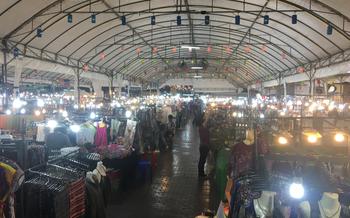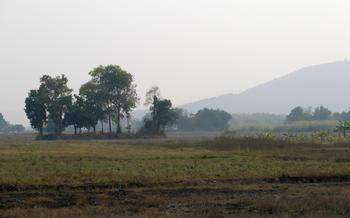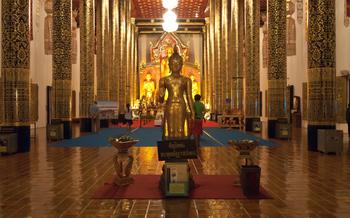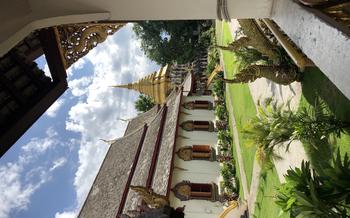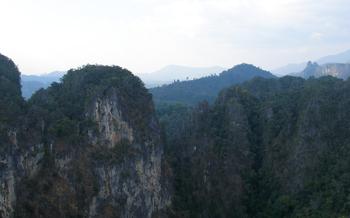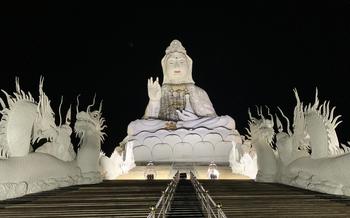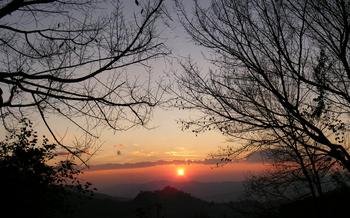
Doi Luang National Park
- Doi Luang National Park: A Realm of Natural Wonders
- Getting to the Park: Embarking on an Adventure
- Accommodations within the Park: Nesting amidst Nature
- Hiking Trails: Unveiling Nature's Masterpieces
- Camping under the Stars: A Symphony of Nature's Lullaby
- Wildlife Encounters: Glimpsing the Kingdom's Treasures
- Birdwatching Paradise: A Symphony of Wings
- Waterfalls: Cascading Beauties in the Jungle's Heart
- Caves and Rock Formations: Nature's Sculptural Masterpieces
- Cultural Heritage: Unveiling the Region's Tapestry of Traditions
- Food and Local Cuisine: Savoring Authentic Flavors
- Festivals and Events: Witnessing Cultural Expressions
- Responsible Tourism: Treading Lightly on Nature's Canvas
- Best Time to Visit: Unveiling Nature's Seasonal Wonders
- Insider Tip: Hidden Gems and Local Secrets
Doi Luang National Park: A Realm of Natural Wonders
Nestled in the heart of Thailand's Phayao province, Doi Luang National Park beckons travelers with its stunning natural beauty, rich biodiversity, and significant conservation efforts. Spanning over 1,250 square kilometers, the park encompasses a diverse range of ecosystems, from lush rainforests and towering mountains to tranquil rivers and cascading waterfalls. As a haven for wildlife enthusiasts and nature lovers, Doi Luang National Park offers a sanctuary to a variety of plant and animal species, including some that are endemic to the region. The park is also home to several endangered species, such as the Asian elephant and the tiger, making it a crucial site for conservation initiatives. With its pristine landscapes, diverse wildlife, and commitment to preserving Thailand's natural heritage, Doi Luang National Park promises an unforgettable wilderness experience.
Getting to the Park: Embarking on an Adventure
Reaching Doi Luang National Park, a haven of natural wonders, requires careful planning and the choice of transportation that best suits your preferences. For those seeking a scenic journey, driving along the winding roads that lead to the park is a delight. Embrace the picturesque landscapes and make spontaneous stops to capture the beauty of your surroundings. Alternatively, if you prefer a more relaxed option, several bus companies offer direct routes to the park from major cities like Chiang Mai, ensuring a comfortable and hassle-free travel experience. To enhance your adventure, consider renting a bicycle or motorbike and embarking on a thrilling ride through the lush countryside, immersing yourself in the sights, sounds, and scents of nature. Whichever mode of transport you choose, the journey to Doi Luang National Park promises to be an unforgettable experience in itself.
Tips for a Seamless Journey:
- Plan your route in advance, taking into account road conditions and potential traffic delays.
- If driving, ensure your vehicle is in good condition and equipped for navigating mountainous terrain.
- Pack snacks and drinks to keep yourself energized during the journey.
- Make use of rest stops along the way to stretch your legs and admire the scenery.
- If traveling by bus, book your tickets in advance, especially during peak season.
- For a truly immersive experience, consider hiring a local guide who can share insights into the region's history and culture.
Accommodations within the Park: Nesting amidst Nature
Doi Luang National Park offers a range of accommodation options within its boundaries, allowing visitors to immerse themselves in the heart of nature. These accommodations cater to diverse preferences and budgets, ensuring a comfortable stay for all.
For those seeking a rustic experience, basic bungalows nestled amidst the forest provide a cozy retreat. Equipped with essential amenities, these bungalows offer a simple yet charming base for exploring the park's wonders.
If comfort is a priority, private cabins with modern facilities offer a more luxurious experience. Complete with private bathrooms, air conditioning, and balconies overlooking the stunning scenery, these cabins provide a tranquil haven for relaxation and rejuvenation.
For budget-conscious travelers, dormitories provide a shared living space with bunk beds. This option allows solo adventurers and groups to socialize and share stories of their park adventures while enjoying affordable accommodation.
Camping enthusiasts can pitch their tents at designated campsites within the park, offering a unique opportunity to connect with nature under the stars. These campsites provide basic facilities such as restrooms and showers, ensuring a comfortable camping experience.
Hiking Trails: Unveiling Nature's Masterpieces
Doi Luang National Park offers a network of well-maintained hiking trails that cater to hikers of all levels. The trails meander through the park's diverse landscapes, showcasing its rich biodiversity and stunning natural beauty.
One of the most popular trails is the Doi Luang Summit Trail, a challenging but rewarding hike that takes you to the summit of Doi Luang, the highest peak in the park. The trail offers breathtaking panoramic views of the surrounding mountains, valleys, and forests.
For a more leisurely experience, the Nature Trail is a great option. This trail winds through the park's lush forests, allowing hikers to observe the diverse flora and fauna. Along the way, you may encounter colorful butterflies, exotic birds, and even shy wildlife such as deer or monkeys.
The Waterfall Trail is another must-do hike, taking you to the base of the park's most impressive waterfalls. The trail offers a refreshing respite from the heat, and the sound of the cascading water creates a tranquil and serene atmosphere.
Remember to wear comfortable shoes, bring plenty of water, and pack a camera to capture the stunning scenery. Hiring a local guide is also an excellent idea, as they can provide valuable insights into the park's flora, fauna, and history.
Whether you're an experienced hiker or a beginner, Doi Luang National Park has a trail to suit your abilities and interests. Embrace the challenge, lace up your boots, and embark on an unforgettable hiking adventure in this natural paradise.
Camping under the Stars: A Symphony of Nature's Lullaby
Doi Luang National Park invites adventurous souls to immerse themselves in nature's embrace by offering designated camping areas. These campsites, nestled amidst the park's pristine wilderness, provide a symphony of sounds and sights that will lull you to sleep. As darkness envelops the forest, the symphony of nature takes center stage. The rustling of leaves, the chirping of crickets, and the distant calls of nocturnal animals create a mesmerizing lullaby that soothes the soul.
Before embarking on your camping adventure, ensure you pack essential gear to make your stay comfortable. A sturdy tent, sleeping bag, and cooking utensils are indispensable. Remember to bring a flashlight or headlamp to navigate the darkness and repel any unwanted visitors.
To ensure a safe and enjoyable camping experience, choose designated campsites and avoid venturing into unmarked areas. These campsites provide basic amenities such as restrooms and water sources. Be mindful of your surroundings, as wildlife may wander into the campsite. Store your food properly and dispose of waste responsibly.
As you settle into your campsite, take a moment to appreciate the beauty of the night sky. Away from the city lights, the stars shine with unparalleled brilliance, painting a celestial canvas that will captivate your gaze. Embrace the tranquility of the wilderness, let the sounds of nature wash over you, and allow yourself to be lulled into a deep and restful slumber.
Wildlife Encounters: Glimpsing the Kingdom's Treasures
Doi Luang National Park is a haven for wildlife enthusiasts, boasting a diverse array of species that roam freely within its lush forests. From majestic elephants and shy leopards to playful gibbons and colorful birds, the park offers ample opportunities for wildlife encounters that will leave you in awe.
One of the highlights of the park is the chance to spot wild elephants. These gentle giants can often be seen grazing peacefully in the meadows or bathing in the rivers. While elephant encounters are thrilling, it's crucial to maintain a safe distance and avoid disturbing these magnificent creatures.
For those seeking a more elusive encounter, the park is home to a small population of leopards. These solitary predators are rarely seen, but their presence can be felt through their distinctive tracks and scratch marks on trees. Patience and perseverance may be rewarded with a fleeting glimpse of these elusive cats.
The park's forests also reverberate with the calls of gibbons. These agile primates swing effortlessly through the trees, their haunting songs echoing through the jungle. Observing these playful creatures in their natural habitat is a truly unforgettable experience.
Doi Luang National Park is also a haven for birdwatchers, with over 300 species recorded within its boundaries. From the vibrant hornbills and colorful pheasants to the melodious songbirds, the park offers a symphony of avian delights. Birdwatching enthusiasts can explore the park's diverse habitats, from dense forests to open grasslands, to spot a wide variety of bird species.
Responsible wildlife viewing is essential when visiting the park. Always maintain a respectful distance from animals, avoid using flash photography, and minimize noise to prevent disturbing them. By following these guidelines, you can ensure that future generations can continue to enjoy the park's rich wildlife.
Birdwatching Paradise: A Symphony of Wings
Doi Luang National Park is a haven for bird enthusiasts, with over 300 recorded species gracing its diverse habitats. The park's unique geography and rich flora create an ideal environment for a wide range of avian life.
One of the best spots for birdwatching is the Huai Mae Ngao Loop Trail. This 6-kilometer trail winds through a variety of habitats, including deciduous forest, mixed dipterocarp forest, and bamboo forest. Along the trail, you can spot a variety of birds, including hornbills, barbets, woodpeckers, and flycatchers.
Another great spot for birdwatching is the park's headquarters. The headquarters is surrounded by a variety of trees and shrubs, which attract a variety of birds, including sunbirds, bulbuls, and drongos.
If you're a serious birdwatcher, be sure to bring your binoculars and a field guide. The park's staff can also provide you with information on the best places to spot birds.
Insider Tip: For a truly unique birdwatching experience, visit the park during the migration season. During this time, the park is visited by a variety of migratory birds from all over Asia.
Waterfalls: Cascading Beauties in the Jungle's Heart
Nestled amidst the lush greenery of Doi Luang National Park, waterfalls cascade like liquid diamonds, adding a touch of magic to the already enchanting landscape. These natural wonders offer a refreshing respite from the jungle's heat and provide countless opportunities for exploration and adventure.
One of the must-visit waterfalls is Pha Chor Waterfall, the park's tallest cascade, which plunges from a height of over 100 meters. The thunderous roar of the water and the mist that envelops the air create a mesmerizing spectacle. Visitors can take a refreshing dip in the pool at the base of the waterfall or simply relax and soak in the beauty of nature's masterpiece.
Another popular waterfall is Pha Ngam Waterfall, known for its unique tiered structure. The water cascades down a series of rocky ledges, creating multiple pools of varying depths, ideal for swimming and wading. Visitors can climb the rocks to reach the different levels of the waterfall, offering stunning views of the surrounding jungle.
For those seeking a more secluded experience, Pha Takhian Waterfall is a hidden gem nestled deep within the park's interior. Surrounded by towering trees and lush vegetation, this waterfall offers a tranquil oasis to escape the crowds. Visitors can enjoy a refreshing swim in the crystal-clear waters or simply relax on the rocks and listen to the soothing sounds of the cascade.
Whether you're seeking adventure or relaxation, Doi Luang National Park's waterfalls offer something for everyone. Embrace the beauty of nature's watery wonders and create lasting memories in this enchanting jungle paradise.
Caves and Rock Formations: Nature's Sculptural Masterpieces
Doi Luang National Park is a treasure trove of fascinating caves and rock formations, each with its own unique story to tell. The most famous cave is Tham Pha Daeng, located near the park headquarters. Visitors can explore its vast chambers and galleries, adorned with stunning stalactites and stalagmites that have been sculpted by water over thousands of years.
For a more adventurous experience, head to Tham Lod, a cave system that can only be accessed by boat. Take a guided tour through its underground tunnels and chambers, and marvel at the intricate rock formations and the eerie silence that envelops the cave.
Another must-see is Pha Daeng, a large rock formation that offers breathtaking views of the surrounding landscape. Hike to the top of the rock for a panoramic vista that will leave you breathless.
Don't miss the opportunity to explore the Tham Pha Pun Cave, which is located near the park's eastern entrance. This cave is home to a large colony of bats, and visitors can witness their mass exodus at dusk, a truly unforgettable spectacle.
Remember to wear appropriate footwear and clothing when exploring the caves, as the ground can be slippery and uneven. Also, bring a flashlight or headlamp, as the caves can be dark and🔦 dimly lit.
Cultural Heritage: Unveiling the Region's Tapestry of Traditions
The region surrounding Doi Luang National Park is a cultural melting pot, home to a diverse array of ethnic groups, each with its unique traditions and customs. Immerse yourself in the vibrant local culture by visiting nearby villages and towns, where you can interact with the friendly locals and learn about their way of life. Explore local markets, where you can find a treasure trove of handmade crafts, traditional clothing, and delicious local delicacies. Participate in traditional festivals and ceremonies, such as the annual spirit house festival, which showcases the region's rich animist beliefs. Engage in conversations with the locals and learn about their history, customs, and folklore. By embracing the cultural heritage of the region, you'll gain a deeper understanding of Thailand's diverse cultural tapestry and create lasting memories of your visit to Doi Luang National Park.
Food and Local Cuisine: Savoring Authentic Flavors
Phayao Province, where Doi Luang National Park is nestled, is a culinary haven waiting to be explored. The region boasts a rich culinary heritage, influenced by both Thai and Lanna traditions. Visitors can indulge in a delectable array of local dishes that showcase the region's unique flavors and ingredients.
One must-try dish is the "Kaeng Hung Lay," a flavorful curry made with tender pork or beef, bamboo shoots, and local herbs. The curry's rich broth and aromatic spices create a harmonious balance of flavors that will tantalize your taste buds. Another local specialty is "Sai Oua," a traditional Northern Thai sausage made with minced pork, herbs, and spices. Grilled or steamed, Sai Oua is a delectable treat that perfectly captures the essence of Phayao's cuisine.
For a refreshing and nutritious snack, visitors can savor the local fruit, known as "Linchee". These sweet and juicy fruits are a symbol of Phayao and are available in abundance during the summer months. Linchee can be enjoyed fresh, or transformed into delicious desserts and beverages.
To experience the authentic flavors of Phayao, venture into the local markets. The "Walking Street Market" held every Saturday evening in Phayao City is a vibrant hub of food stalls, where visitors can sample a variety of local delicacies. From grilled meats and fresh seafood to traditional sweets and tropical fruits, the market offers a culinary adventure that will satisfy every palate.
When visiting Doi Luang National Park, take advantage of the opportunity to dine at one of the park's restaurants. These restaurants offer a range of local dishes, allowing visitors to savor the region's culinary delights while immersing themselves in the park's natural beauty.
Festivals and Events: Witnessing Cultural Expressions
Doi Luang National Park is not just a haven for nature enthusiasts but also a place where cultural traditions are deeply rooted. Throughout the year, various festivals and events are held in the surrounding communities, providing visitors with an opportunity to immerse themselves in the region's rich cultural heritage.
One of the most significant festivals is the Phayao Boat Procession, held annually in February or March. This colorful festival showcases the region's vibrant Lanna culture, featuring elaborately decorated boats parading along the Ing River. Visitors can witness traditional music and dance performances, as well as partake in the lively processions and festivities.
Another highlight is the Doi Luang National Park Birdwatching Festival, held in November or December. This event attracts bird enthusiasts from around the world, as the park is home to over 300 species of birds, including many rare and endangered species. Visitors can participate in guided birdwatching tours, workshops, and exhibitions, and experience the thrill of spotting these magnificent creatures in their natural habitat.
To delve deeper into the local culture, visitors can explore the nearby Ban Thung Bua Village, renowned for its traditional weaving and silk production. Here, they can witness the intricate process of silk making, from raising silkworms to weaving beautiful fabrics, and even try their hand at the craft themselves.
By attending these festivals and events, visitors can gain a deeper understanding of the region's cultural heritage, traditions, and way of life, making their trip to Doi Luang National Park a truly enriching and memorable experience.
Responsible Tourism: Treading Lightly on Nature's Canvas
As you embark on your journey through Doi Luang National Park, it is crucial to embrace the principles of responsible tourism. This park is a haven for wildlife, and your actions can significantly impact its delicate ecosystem. To ensure the park's pristine beauty and biodiversity for future generations, consider the following practices:
-
Leave No Trace: Adhere to the "leave no trace" principle by packing out all your trash and avoiding littering. Dispose of waste properly in designated bins or carry it out with you.
-
Minimize Disturbance: Observe wildlife from a distance and avoid approaching or disturbing them. Respect their natural behaviors and habitats, and never feed or interact with wild animals.
-
Respect Cultural Heritage: Show respect for the local communities and their traditions. Ask permission before entering sacred sites or taking photographs of people. Support local businesses and initiatives that promote sustainable tourism.
-
Reduce Carbon Footprint: Opt for eco-friendly transportation options, such as bicycles or electric vehicles, to minimize your carbon footprint. Consider carpooling or using public transportation to reduce emissions.
-
Support Conservation Efforts: Engage with local conservation organizations and initiatives that support the protection of the park's ecosystem. Consider making a donation or volunteering your time to contribute to these efforts.
By embracing responsible tourism practices, you can help preserve the natural beauty and ecological integrity of Doi Luang National Park while ensuring a sustainable and enjoyable experience for all visitors.
Best Time to Visit: Unveiling Nature's Seasonal Wonders
The allure of Doi Luang National Park transcends seasons, offering diverse experiences throughout the year. The cool and dry season from November to February presents ideal conditions for hiking and camping, with clear skies and moderate temperatures. During this period, the park's lush vegetation is at its peak, creating a vibrant tapestry of colors.
The hot season from March to May brings with it a symphony of wildflowers, transforming the park into a kaleidoscope of colors. This is also a great time to spot wildlife as animals gather around water sources.
The rainy season from June to October unveils the park's hidden waterfalls at their fullest, creating a mesmerizing spectacle of cascading waters. While trails may be more challenging during this period, the lush greenery and abundant birdlife compensate for any inconvenience.
No matter the season, Doi Luang National Park offers a unique and unforgettable experience. Whether you seek tranquility amidst nature's embrace or thrilling adventures, this park has something for every traveler.
Insider Tip: Hidden Gems and Local Secrets
Beyond the well-trodden paths, Doi Luang National Park holds hidden gems waiting to be discovered. Venture off the beaten track to stumble upon secluded waterfalls, tranquil forest glades, and breathtaking viewpoints that few tourists know about. Ask local guides or park rangers about these secret spots; they'll gladly point you in the right direction.
One such hidden gem is the Pha Daeng Viewpoint, offering panoramic views of the park's lush forests and distant mountains. For a unique perspective, embark on a night hike to witness the mesmerizing starry sky from this vantage point.
Another local secret is the Namtok Pha Kluay Waterfall, tucked away in a secluded corner of the park. Its cascading waters and natural pool invite you to take a refreshing dip and escape the summer heat.
For those seeking a more immersive experience, consider hiring a local guide to lead you on a jungle trek. They'll share their knowledge of the park's flora and fauna, helping you spot hidden wildlife and discover medicinal plants used by local communities.
Remember, respecting the park's natural environment is paramount. Stick to designated trails, avoid littering, and refrain from disturbing wildlife. By embracing responsible travel practices, you'll help preserve these hidden gems for future generations to cherish.
